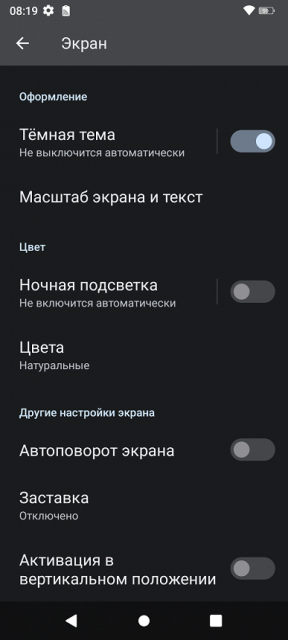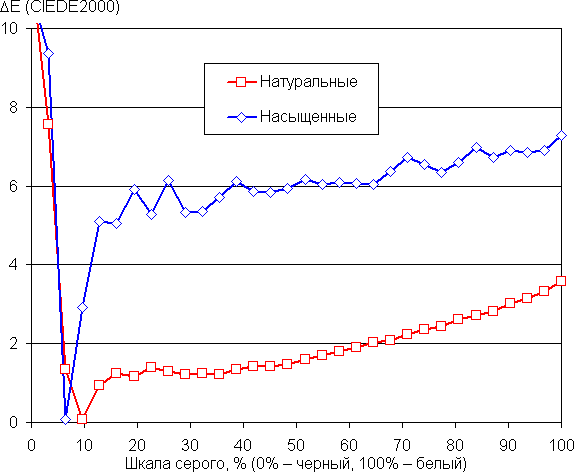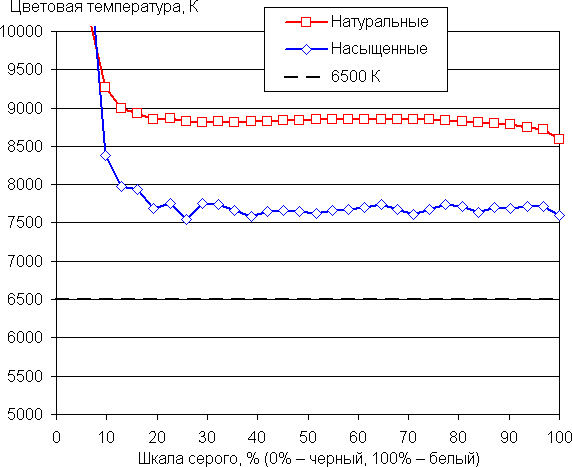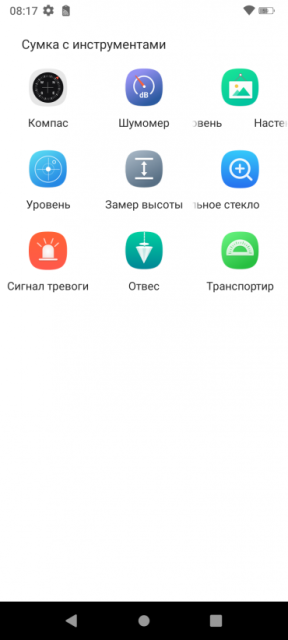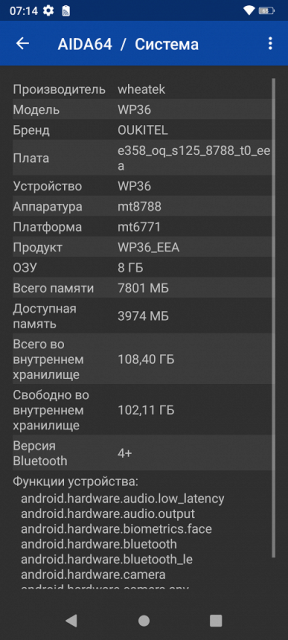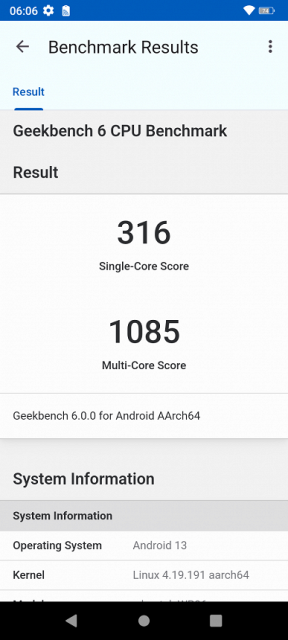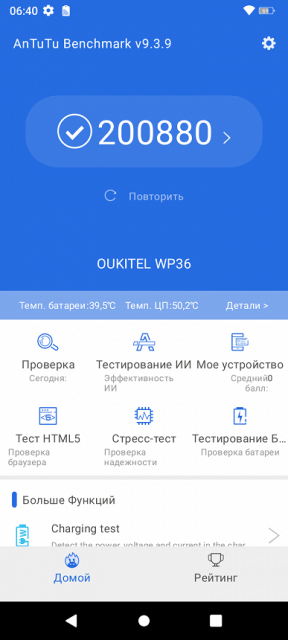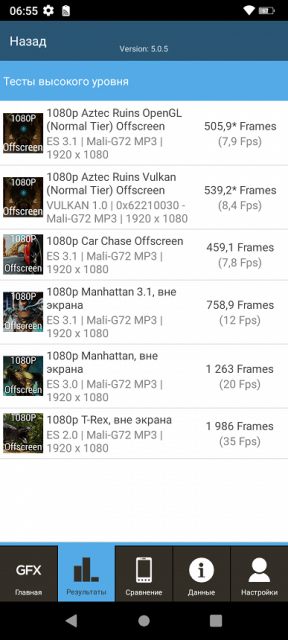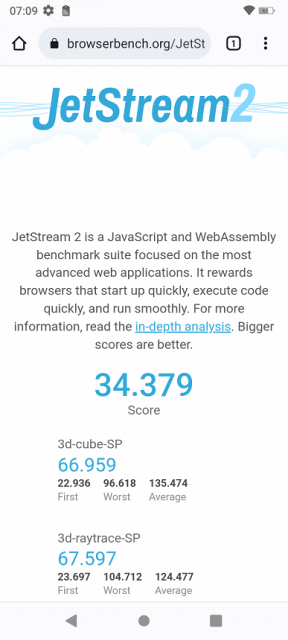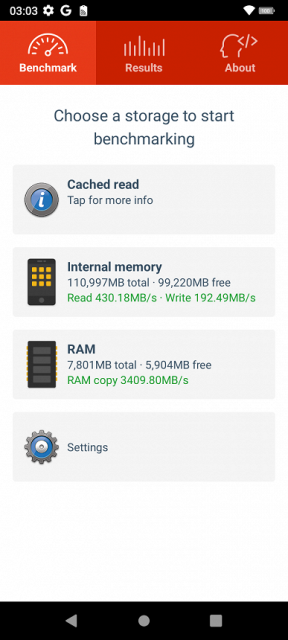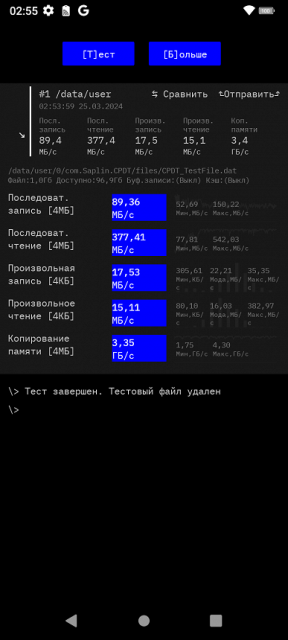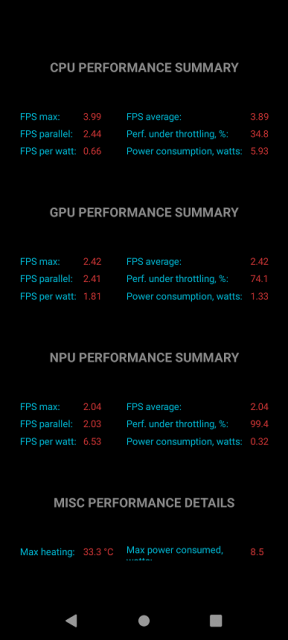The Oukitel WP36 rugged smartphone, which has attracted many people's attention, has appeared on the market and can withstand a wide variety of extreme conditions without fear of moisture or dust. In addition, this phone is equipped with an impressive battery capacity and an impressively powerful speaker comparable to a mobile speaker system.

Main characteristics of Oukitel WP36
- SoC Mediatek MT8788, 8 processor cores (4×Cortex-A73 @2.0 GHz + 4×Cortex-A53 @2.0 GHz)
- GPU Mali-G72
- Operating system Android 13
- Touch display IPS, 6.52″, 720×1600, 60 Hz, 20:9, 269 ppi
- RAM 8 GB, internal memory 128 GB
- microSD support (combined slot)
- Nano-SIM support (2 pcs.)
- Networks 2G GSM, 3G WCDMA, 4G LTE
- GPS, Glonass, Galileo, BDS
- Wi-Fi 5 (2.4/5 GHz)
- Bluetooth 5.0, A2DP, LE
- NFC
- USB 2.0 Type-C, USB OTG
- There is no 3.5mm audio output for headphones
- Rear camera 13 MP, video 1080p@30 fps
- Front camera 5 MP
- Proximity and lighting sensors, magnetic field, accelerometer, gyroscope
- Fingerprint scanner (side-mounted)
- Protection IP68/IP69K, MIL-STD-810H
- Battery 10600 mAh
- Speaker 3.5 W, 128 dB
- Dimensions 172×81×19.1 mm
- Weight 394 g
Appearance and ease of use
The body of the Oukitel WP36 smartphone is designed in a style typical of rugged devices, with thickened, rubberized edges that provide reliable protection to the internal components from shocks and other external influences. It features screw-on side plates for added reinforcement, corner bulges for added strength, and a special hole for attaching a strap. The case has a matte, rough-to-the-touch surface that leaves no fingerprints and provides a secure grip even in wet hands.
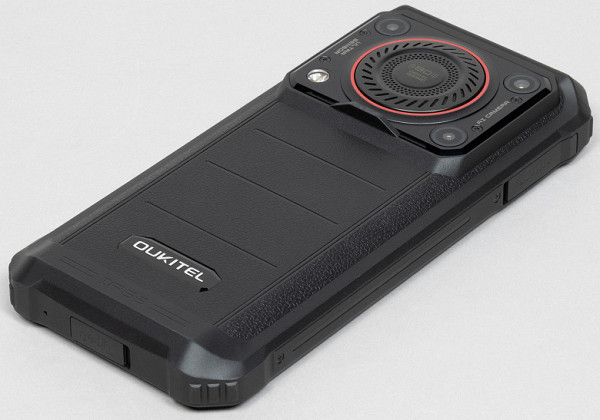
This smartphone has an impressive size and significant weight, making it less convenient to carry in the pocket of everyday clothes. Such dimensions and heaviness of the device are largely due not only to the thickened side walls, but also to the introduction of a high-capacity battery. However, for enthusiasts of rugged smartphone models, such characteristics are familiar, and they have long adapted to such features.
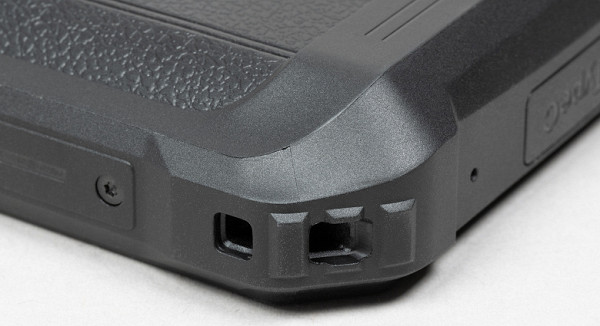
The device connectors are reliably protected with rubber covers. Thanks to the IP68 standard, the smartphone can withstand immersion under water to a depth of 1.5 meters for an hour and a half, and is also reliably protected from dust, dirt and sand. In addition, the device provides drop protection up to 1.5 meters and meets the military MIL-STD-810H durability standard.
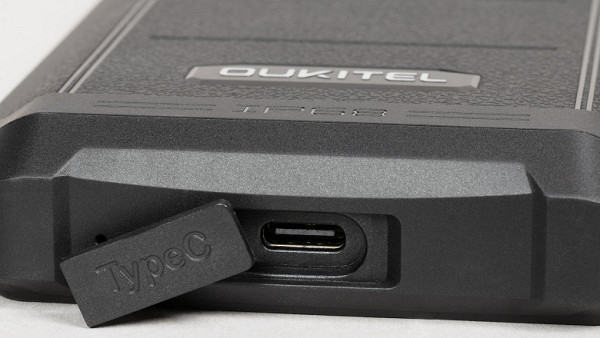
You can install two Nano-SIM cards in the combined tray under the rubber flap on the left side, or replace one of them with a microSD memory card.
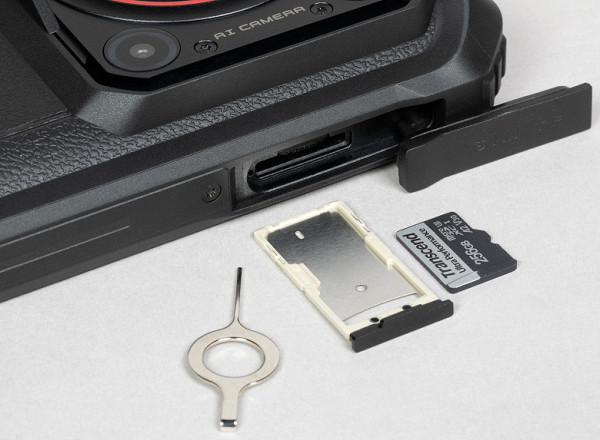
Of course, the use of an additional protective case for such a smartphone is not required. When the smartphone is lying on a table, it does not rest on the protruding camera lens or external speaker, but is supported by a protruding part of the body specifically designed for this purpose.

In terms of control, in addition to two standard buttons on the right side, there is a separate fingerprint scanner, which is not integrated into the button, but installed separately. The buttons are large enough to make them easy to find by touch.
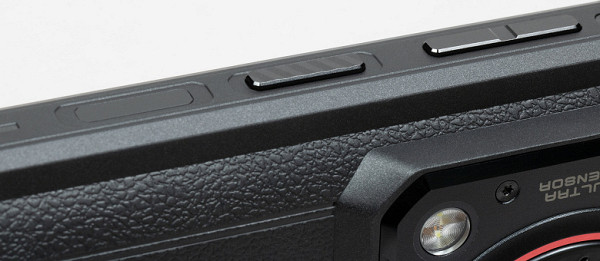
The high-volume mono speaker is interestingly integrated into the design: it is located in the center of the back of the smartphone, while the cameras and flash are symmetrically placed around it at the edges, emphasizing its dominant position.
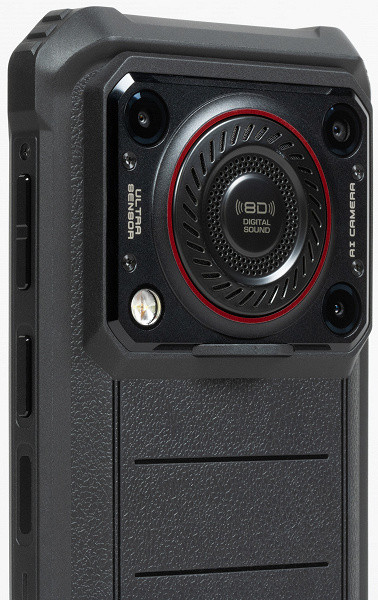
The bezel around the screen is quite thick, reminiscent of devices from yesteryear. However, for some reason they chose to place the front camera not in this frame, but to use a drop-shaped cutout on the screen for it, thereby reducing its working area. It is unclear why this decision was made, given that there would be enough space at the top to accommodate several cameras...
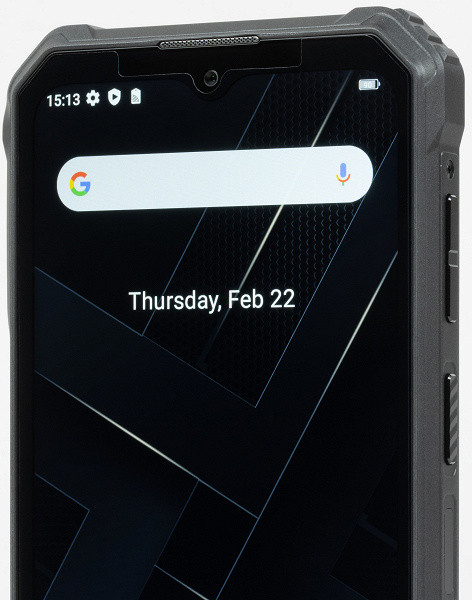
A conversational microphone and a USB Type-C connector are installed at the bottom end.
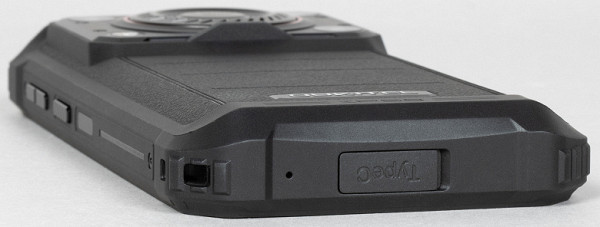
The top end contains only a hole for an additional microphone.
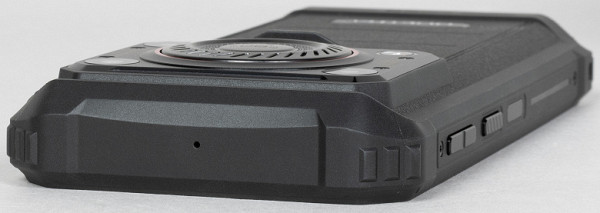
Screen
The Oukitel WP36 smartphone is equipped with a 6.52-inch IPS display with a resolution of 720×1600, protected by flat Corning Gorilla Glass 5. The pixel density is 269 ppi. The maximum screen refresh rate is limited to 60 Hz, and multi-touch is supported up to three simultaneous touches.
The front surface of the screen is made of glass with a smooth, scratch-resistant surface. The anti-glare properties of this screen are slightly better than those of the Nexus 7. There may be an oleophobic coating on the outer surface of the screen, which makes it easier to remove fingerprints. The maximum screen brightness is 435 cd/m², which, combined with anti-glare properties, ensures sufficient visibility even in the sun. Brightness adjustment occurs automatically depending on lighting conditions and can be changed by the user. The screen does not flicker at any brightness level. The IPS matrix provides good color reproduction and viewing angles.
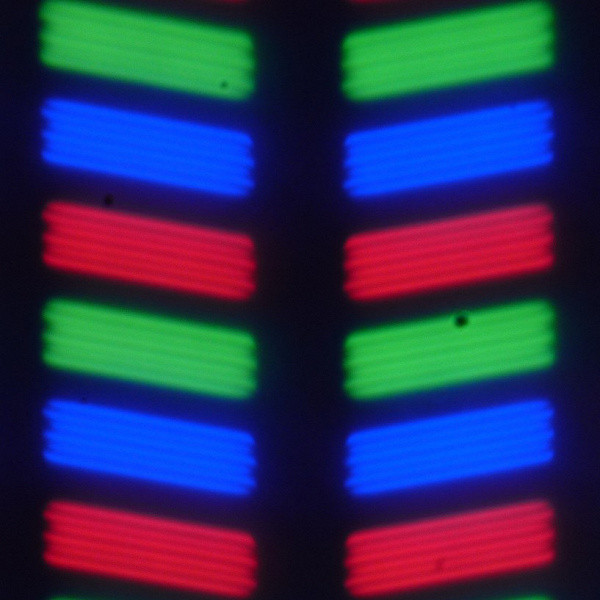
To compare the screens of the smartphone and the Nexus 7, photographs were taken showing the same images. At the time of shooting, the brightness of the screens was approximately 200 cd/m², and the color balance on the camera was set to 6500 K.
The photographs show images with a white background (Natural profile).
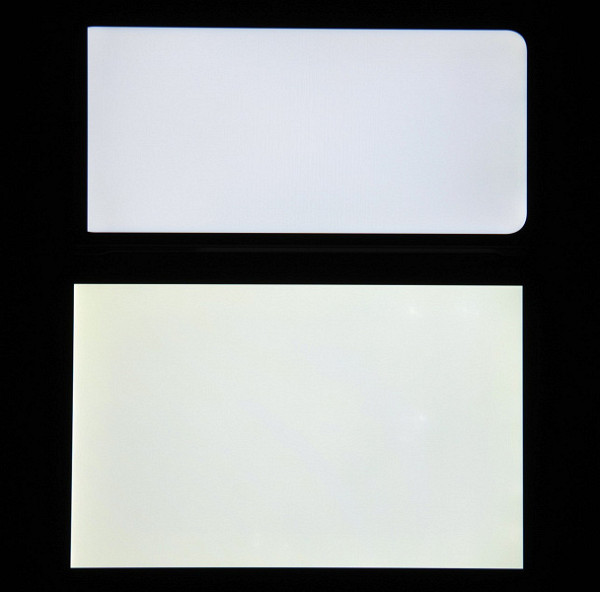
Note the good uniformity of brightness and color tone of the white field.
And a test picture (Natural profile):
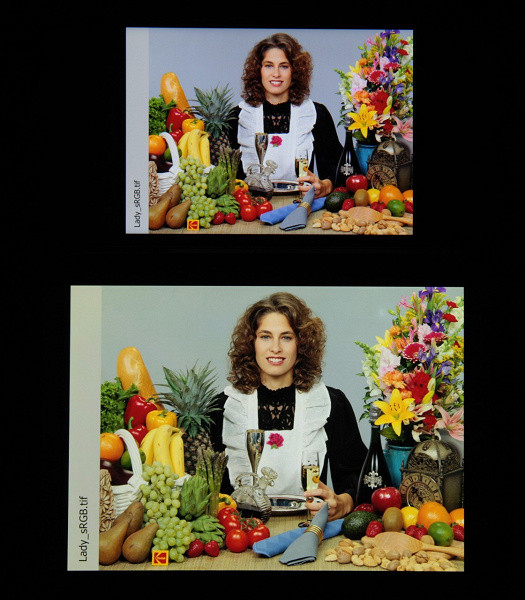
Color saturation is within normal limits, but the color balance of screens varies. It is important to note that the photograph may not be a completely reliable source of information regarding color accuracy and is provided for illustrative purposes only. This is due to the fact that the spectral sensitivity of the camera sensor may differ slightly from human vision.
The photo above was taken using the «Natural» profile in the screen settings. The total number of available profiles is three.

The Vivid profile is characterized by increased color saturation due to increased color contrast:
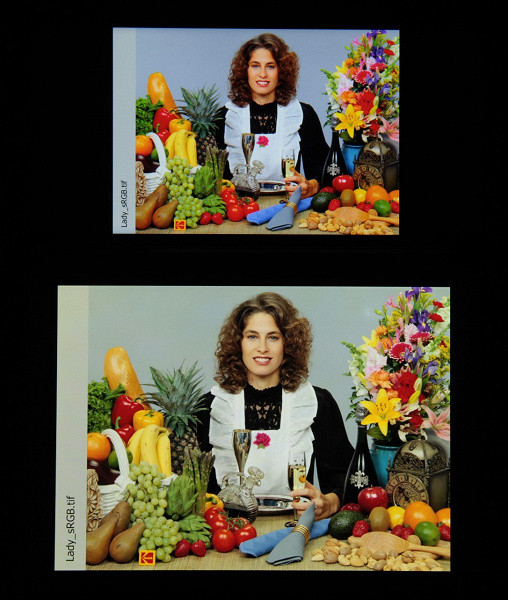
Profile Saturated — color saturation is normal, shades are slightly warmer:
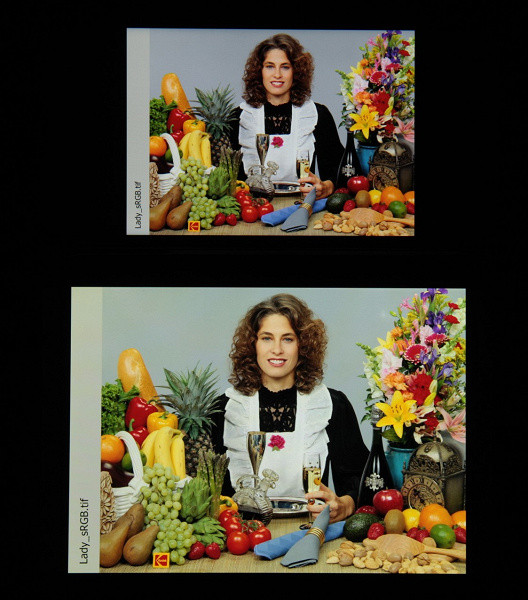
The smartphone screen has excellent viewing angles, maintaining colors without noticeable distortion even when the gaze deviates significantly from perpendicular to the screen and without changing shades. However, when deviated diagonally, the black field becomes noticeably lighter and may acquire a slight purple or yellowish tint.
When viewed directly, the black field on the screen remains uniform and maintains contrast well (for better visibility, the brightness of the smartphone screen backlight is increased).
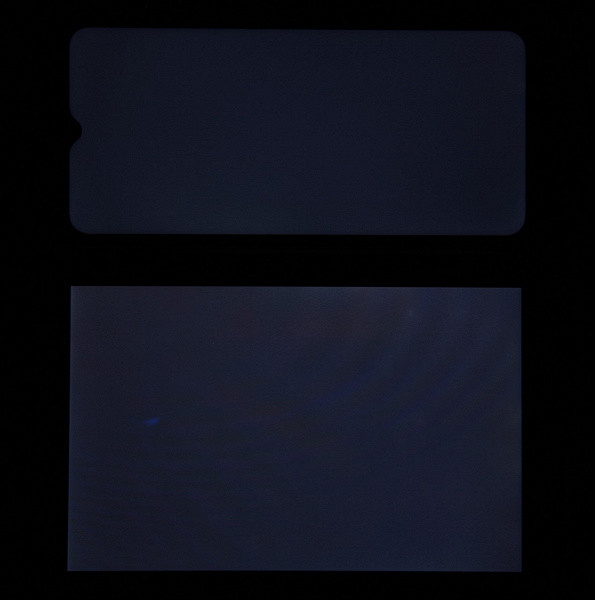
The screen contrast (approximately in the center) is quite high and is about 1500:1. The response time from black to white and back is 23ms (13ms on and 10ms off). The transition between gray shades 25% and 75% by color value and back takes a total of 36 ms.
A gamma curve plotted over 32 equally spaced grayscale points shows no significant deviations in either highlights or shadows. The exponent of the approximating power function is 2.25, which is slightly higher than the standard value of 2.2. In this case, the real gamma curve shows a slight deviation from the power-law dependence.

We didn't find the presence of dynamic backlight brightness adjustment, which automatically adjusts the brightness according to the displayed image, which is a very positive result.
The screen color gamut is close to the sRGB standard.
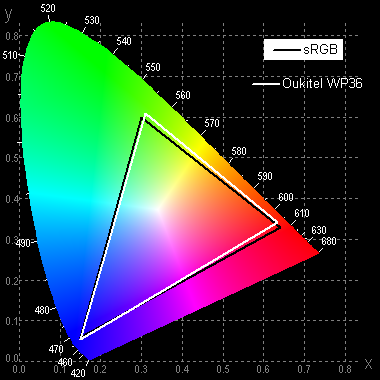
The spectra show that the matrix filters moderately mix the components with each other:
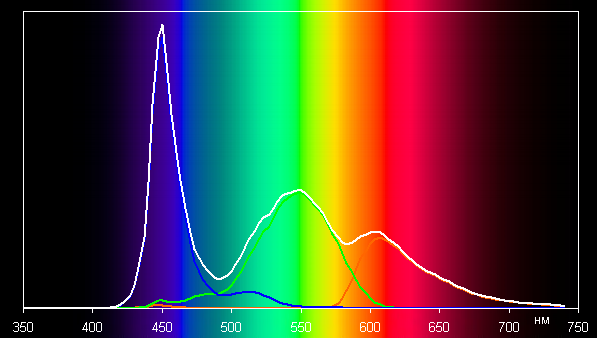
The grayscale balance is at a compromise level. In the “Natural” profile, the color temperature is significantly higher than the standard 6500 K, but the deviation from the blackbody spectrum (ΔE) is relatively low. While in the «Saturated» profile the color temperature is lower, but the ΔE is higher. In both cases, color temperature and ΔE change slightly from hue to hue, which has a positive effect on the visual assessment of color balance.
Of course, there is a function to reduce the intensity of the blue component.
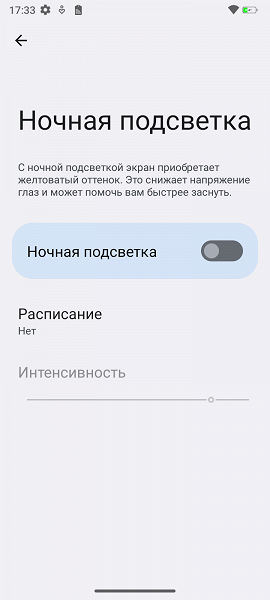
In general, bright light can disrupt the circadian rhythm, but this problem can be resolved by lowering the brightness to a comfortable level while maintaining color balance without reducing the contribution of blue light. Using color balance adjustment for this purpose does not make sense, since even minimal correction will reduce the color temperature below the standard 6500 K (up to 5300 K).
This machine probably doesn't support DisplayPort Alt Mode for USB Type-C, which means it won't be able to output video and audio to an external device via the USB port.
So, the screen does not have the highest maximum brightness (up to 435 cd/m²), but has excellent anti-glare properties, which allows it to be used even in sunlight. The brightness can be reduced to a comfortable level in complete darkness (up to 1 cd/m²), and the auto-brightness mode works adequately. Benefits include no airgap or flicker, high contrast (1500:1), uniform black field and near-sRGB color gamut. Weaknesses include low oleophobic coating, poor black stability when looking away, and reduced resolution. Overall, the screen quality is not considered high, even considering its class of devices.
Camera
The Oukitel WP36 smartphone is equipped with one rear camera, and there is an additional 2-megapixel module for macro photography.
The main camera has a 13 MP matrix resolution and an f/2.2 lens. It does not have the fastest autofocus and electronic stabilization. Photos taken with this camera are basic, with some shortcomings such as blown highlights, soft spots throughout the frame, and a lack of detail. However, the images look vibrant and attractive enough in miniature form, which is probably good enough for sharing on social media.
It is better not to use your smartphone camera at night.

The smartphone allows you to shoot video in resolutions up to 1080p at 30 frames per second. However, video quality leaves much to be desired: the image is not very detailed, the picture can be unstable, there is a noticeable strobe effect, and autofocus can be adjusted on the fly even in good lighting. The sound, however, is recorded quite well.
The selfie camera is equipped with a 5 MP sensor and is also capable of shooting video in 1080p resolution at 30 frames per second, but the shooting quality remains at a basic level.

Telephone and communications
The Oukitel WP36 smartphone supports mobile networks up to 4G and works reliably in the urban areas of the Moscow region, providing a stable connection and quick restoration of communication after a break.
In addition, the device is equipped with a Wi-Fi 5 wireless adapter (802.11a/b/g/n/ac, 2.4/5 GHz), Bluetooth 5.0 and NFC support.
The single-channel satellite navigation module supports GPS, Glonass, Galileo and BDS. Satellites are quickly detected during a cold start, and the positioning accuracy is not satisfactory.
The caller's voice sounds loud and clear through the speaker. Medium power vibration motor. However, the built-in set of sensors is limited to basic functions, and does not even provide a gyroscope, let alone a barometer. This is somewhat unexpected for a smartphone intended for active use, where an expanded set of sensors is expected.
Software and multimedia
The Oukitel WP36 smartphone runs on an almost pure version of the Android 13 operating system. It adds several utilities typical of off-road smartphones: compass, plumb line, height meter, flashlight, protractor, level, alarm, voice recorder and some other functions, such as a magnifying glass. There's also an FM radio, although headphones are required for operation. Children's and game modes are available. It is important to remember to disable DuraSpeed's «application jammer» feature, otherwise applications may unexpectedly close from RAM.
The smartphone has a speaker, unusual for such devices, with a power of 3.5 W and a peak volume of 128 dB. The manufacturer called the sound effect “8D”, but did not explain its meaning. Two of these speakers are not installed in the smartphone due to their volume, so the sound is monophonic, but extremely loud — even so much that it can deafen. This volume level allows you to use your smartphone as a music speaker on a picnic, as well as as a means of sending a distress signal during out-of-town adventures.
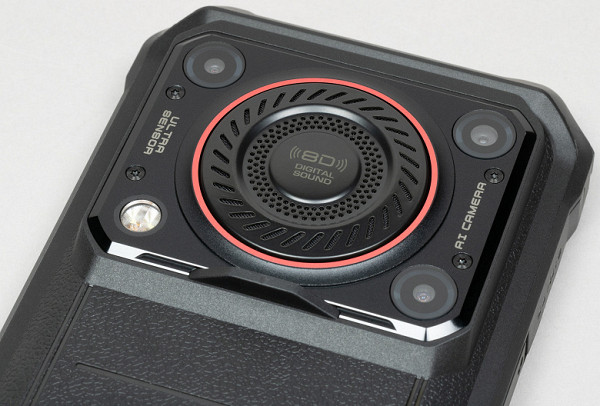
Performance
The Oukitel WP36 smartphone runs on an eight-core Mediatek MT8788 processor with a Mali-G72 GPU. The amount of RAM is 8 GB, expandable up to 16 GB virtual. There is plenty of built-in storage — 128 GB, and it is possible to use a memory card. The smartphone also supports connecting external devices via the USB Type-C port in USB OTG mode.
The platform is manufactured using a 12 nm process technology and offers a basic level of performance: in the AnTuTu test, the smartphone reaches only 200 thousand points. For everyday tasks and working with the interface, its capabilities are quite sufficient, although some delays may occur when using the camera. However, this performance may not be enough to run demanding games.
Testing in comprehensive tests AnTuTu and GeekBench:
All results obtained during testing of the smartphone were presented in tables for ease of comparison. Typically, the table also includes results from other devices from different market segments tested on the latest versions of the benchmarks. This helps to visually evaluate numerical data. However, due to benchmarking limitations, we are unable to include results from other models tested on older versions of the benchmark programs.
| Oukitel WP36 (Mediatek MT8788) | Ixxi Khan J8 Pro (Mediatek Helio G95) | Tecno Pova 5 (Mediatek Helio G99) | Samsung Galaxy XCover7 (MediaTek Dimensity 6100 Plus) | Poco X5 Pro 5G (Qualcomm Snapdragon 778G) | |
|---|---|---|---|---|---|
| AnTuTu (v9.x) (bigger is better) | 200880 | 340480 | 383174 | 344317 | 536193 |
| GeekBench 6 (bigger is better) | 316/1085 | 661/1788 | 715/1976 | 695/1884 | 941/2640 |
Testing the graphics subsystem in 3DMark and GFXBenchmark gaming tests:
| Oukitel WP36 (Mediatek MT8788) | Ixxi Khan J8 Pro (Mediatek Helio G95) | Tecno Pova 5 (Mediatek Helio G99) | Samsung Galaxy XCover7 (MediaTek Dimensity 6100 Plus) | Poco X5 Pro 5G (Qualcomm Snapdragon 778G) | |
|---|---|---|---|---|---|
| 3DMark Wild Life Extreme Vulkan (bigger is better) | 185 | 423 | 348 | 339 | 687 |
| 3DMark Wild Life Vulkan (bigger is better) | 646 | 1509 | 1252 | 1224 | 2450 |
| GFXBenchmark Manhattan ES 3.1 (1080p Offscreen, fps) | 12 | 32 | 26 | 25 | 56 |
| GFXBenchmark T-Rex (1080p Offscreen, fps) | 35 | 85 | 64 | 61 | 132 |
Testing in browser cross-platform tests:
| Oukitel WP36 (Mediatek MT8788) | Ixxi Khan J8 Pro (Mediatek Helio G95) | Tecno Pova 5 (Mediatek Helio G99) | Samsung Galaxy XCover7 (MediaTek Dimensity 6100 Plus) | Poco X5 Pro 5G (Qualcomm Snapdragon 778G) | |
|---|---|---|---|---|---|
| Google Octane 2 (bigger is better) | 10593 | 18786 | 22823 | 22282 | 27070 |
| JetStream (bigger is better) | 34 | 52 | 72 | 70 | 73 |
Memory speed test results:
Heat
We test for performance degradation when heated using the Burnout Benchmark program, which allows you to load the CPU, GPU and NPU:
| Stress on | Heating performance as a percentage of maximum |
|---|---|
| CPU | 35% |
| GPU | 74% |
| NPU | 99% |
Battery life
The Oukitel WP36 smartphone is equipped with a 10600 mAh battery, although it is not replaceable. Despite the declared gigantic volume, the actual autonomy of the device is not impressive enough to claim that it lasts twice as long as conventional modern smartphones. Autonomy remains at a high level, but does not go beyond it. This may be due to the MediaTek platform being less than efficient and not optimized.
Testing was carried out at normal power consumption levels, without using power saving functions, although such functions are included in the device. The screen brightness was set to the minimum comfortable level (approximately 100 cd/m²). The tests included continuous reading in the Moon+ Reader application, watching HD videos over a home Wi-Fi network, and playing Injustice 2 with automatic graphics settings.
| Battery capacity | Reading mode | Video mode | 3D Game Mode | |
|---|---|---|---|---|
| Oukitel WP36 | 10600 mAh | 25:00 | 22:00 | 9:00 a.m. |
| Samsung Galaxy XCover7 | 4050 mAh | 18:30 | 15:30 | 6:00 am |
| Ixxi Khan J8 Pro | 6150 mAh | 25:00 | 19:00 | 8:00 am |
| Tecno Pova 5 | 6000 mAh | 23:00 | 16:00 | 7:30 am |
| Tecno Camon 20 Premier 5G | 5000 mAh | 25:00 | 19:00 | 7:00 am |
| Vivo V27 | 4600 mAh | 25:00 | 19:00 | 7:00 am |
| Poco X5 Pro 5G | 5000 mAh | 18:00 | 20:00 | 7:00 am |
| Realme 10 Pro+ 5G | 5000 mAh | 19:00 | 18:00 | 5:00 a.m. |
| Xiaomi 12T | 5000 mAh | 19:00 | 16:00 | 6:00 am |
All figures shown represent the maximum possible results achieved under «ideal» conditions, including no SIM cards installed. Any changes in usage will likely result in a deterioration in these results.
The smartphone fully charges in 4 hours to replenish its large battery. It does not support wireless charging. However, the device can be used as a portable charger to reverse charge other mobile devices, although this requires purchasing a special adapter that is not included in the package.
Bottom line
A new smartphone can be purchased for $120. Despite the simple filling, including a low-quality screen with low resolution, a weak hardware platform and a basic camera, the price can hardly be called too high. Rugged devices are always of interest to their audience, where technical characteristics do not play a major role. For lovers of an active lifestyle, hiking and workers in adverse conditions, such a smartphone can become a reliable partner. And thanks to the protection and long battery life, the device satisfies many needs.

